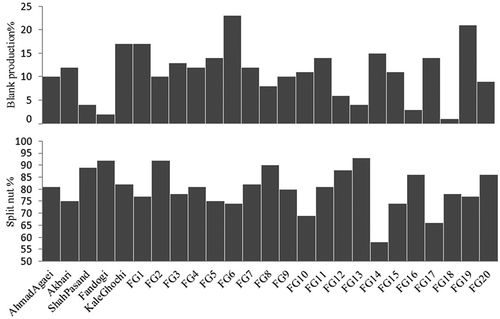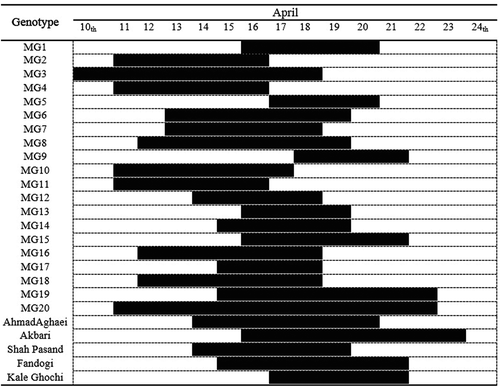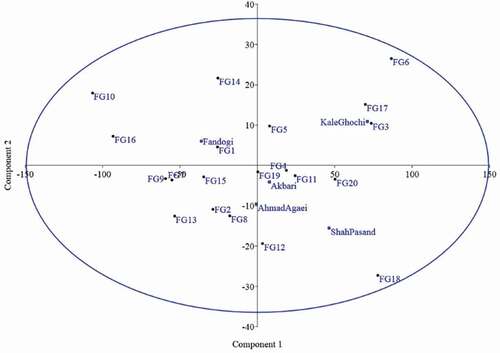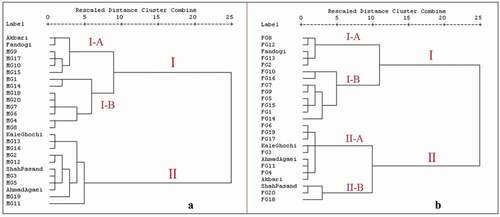ABSTRACT
Pistachio is one of the most important and high economic nut crops in the world. In the present research, the phenological and pomological traits of twenty superior male genotypes (MG) and twenty superior female genotypes (FG) of a pistachio open-pollinated population were evaluated along with five Iranian commercial pistachio cultivars in Damghan, Iran. A multilayer perceptron neural network (MLP) was also used for sensitivity analysis of kernel and nut traits based on leaf and shoot properties. The nut dry weight in selected female genotypes was between 0.7 and 1.28 g, in kernel dry weight between 0.34 and 0.63 g, and in the percentage of split nuts were between 58% and 93%. FG17 with the largest nut and kernel length and FG18 genotype with big green kernel have the heaviest kernel and nut dry weight. Flowering time and nut harvesting times had wide variation among genotypes. The MG20 was identified as male genotypes with a long flowering period (12 days). According to MLP analysis, leaf length, inflorescence rachis length, and width had the highest sensitivity coefficient. The results indicated that most of the genotypes were suitable in terms of nut and kernel weight and size, and kernel color which can be examined for field trials. Furthermore, they could be useful as a parent to be crossed to generate appropriate populations or improve cultivars.
Introduction
Pistachio (Pistacia vera L.) as a green-gold tree is one of the most important and popular nuts that has great economic and business value (Benmahioul et al., Citation2012; Rezaei et al., Citation2019). On the other hand, pistachio species have a high potential for the adaptation of low-environmental conditions such as water and soil salinity and drought which makes it an ideal candidate for cultivation in desert areas, under unfavorable environmental conditions (Karimi, Citation2012). The native species of pistachio genus have spread from India to the Mediterranean area (Rezaei et al., Citation2019) and the north of Afghanistan, northeast of Iran and Central Asia are introduced as the main centers of diversity for pistachio (Kafkas et al., Citation2006). The level of genetic diversity in pistachio is high and large variation is easily observed in seedling trees derived from the seeds of an individual tree (Baghizadeh et al., Citation2010).
Since the measurement and recognition of genetic diversity are beneficial and important to the breeding programs and introduce the promising cultivars (Heidari et al., Citation2019), Seedling-selection trails from the crossing of individual pistachio tree have potentially a novel combination of useful traits for pistachio industry (Kallsen et al., Citation2009). The most commercially available pistachio cultivars are the result of the selection of chance seedlings (Parfitt et al., Citation1995). Kerman, the most important California pistachio cultivar, is a selection of plants coming from seeds in the Kerman area (Iran) (Parfitt et al., Citation1995). Evaluation of genetic diversity using pomological and morphological traits, as a quick method, has been used to identify the appropriate pistachio genotypes (Abidi, Citation2016; Boualem et al., Citation2015; Kazankaya et al., Citation2008; Rezaei et al., Citation2019; Yarılgaç and Yalcin, Citation2007). The traits related to fruit such as low blank nut production, split nuts, kernel percentage, and kernel weight have high values in marketing and sales of pistachio (Rezaei et al., Citation2019).
Iran is one of the most important pistachio sources of gene pools and genetic resources in the world (Khadivi, Citation2018; Pazouki et al., Citation2010). The most important commercial pistachio cultivars of Iran are ‘Akbari’, ‘Kalah Gochi’, ‘Ahmad Aghaei’ and ‘Ohadi’ (Parfitt et al., Citation1995). The evaluation and identification of these valuable genotypes are important for introducing new cultivars with high-quality potential. Therefore, the objective of this study was the evaluation of the pomological and morphological diversity of 40 top pistachio seedling trees to introduce the new male and female promising pistachio genotypes.
Materials and Methods
Plant Materials
The present research was conducted on a pistachio collection containing 800 pistachio trees with 25-year-old trees which are obtained from open-pollinated seeds of two main local cultivars, ‘Kalah Gochi’ and ‘Shah Pasand’ in Damghan Pistachio research station, Agriculture Research, and Education Center of Semnan, Iran. Damghan Pistachio research station is located at 36ᵒ 9′ 4.20″N latitude, 54ᵒ 23′ 7.56″E longitude and 1161 m above the sea level with an annual average temperature of 15.4 ᵒC and annual average precipitation of 213 mm. All irrigation and horticultural practices, fertilizer application in collection with exception pruning were similar to commercial pistachio orchards. All trees were grown in several trunks and no training and pruning operations were done on them. All the studied pistachio genotypes were healthy and mature. Among 800 pistachio tree genotypes, 20 male genotypes (MG1 to MG20) and 20 female genotypes (FG1 to FG20) were selected based on pollen productivity, flowering period, and yield and tolerant to environmental conditions. Five commercial pistachio cultivars (‘Shah-pasand’, ‘Kaleh ghochi’, ‘Ahmad aghaei’, ‘Fandoghi’ and ‘Akbari’) with 20-year old trees in another pistachio collection in Damghan Pistachio research station were selected for comparison and evaluation of their phenological and pomological characterizes to male and female pistachio genotypes.
Morphological Measurements
In this study, 41 characteristics of phenological and pomological traits (25 of fruits related traits and 13 of vegetative properties) were measured in FGs according to pistachio descriptor (IPGRI 1997) (), and vegetative traits were measured in MGs. Kernel and nut dimensions (length and diameter) and thickness were measured using a digital caliper in 20 replicates. The dry and fresh weight for nut, kernel, shell, and hell were measured using an electronic balance with 0.01 g precision in 100 replicates. Leaf, terminal leaflet and inflorescent length and width were measured with a regular ruler in 20 replicates in each tree. Split and blank pistachio percentage was estimated as a split and blank nut numbers in 100 randomized nuts in each genotype. The current season growth of four randomized select shoots was measured at the end of summer in each genotype, and the average values were used. Phenological and flowering traits included the date of first blooming in male inflorescent and flowering period in selected MGs and five cultivars and harvesting dates in FGs. The date of the first blooming was recorded in early spring, when over 5% of flowers had bloomed. The harvesting date was recorded when the hull was cracked and separated from the shell. Since phenological traits vary with environmental conditions (Javanshah, Citation2010), data on all of these traits were adjusted to the standard genotype. On this basis, the earliest flowering and harvesting genotype(s) was considered as a reference standard and was thus scored as zero; for all others, the number of days after the reference standard was scored.
Table 1. Descriptive statistics for quantitative and qualitative morphological traits in pistachio genotypes
Statistical Analysis
The values of mean, minimum and maximum and coefficient of variation (CV%) were calculated for each quantitative variable using SPSS software ver. 19. Principal component analysis (PCA) was used to identify the eigenvalues and eigenvectors. The bi-plot of the first two PCs was drawn by PAST statistics software (Hammer et al., Citation2001). The mean of each trait was normalized before cluster analysis using Z-scores to avoid the effects due to scaling differences and Ward’s method was used to cluster analysis by using SPSS.17 software.
Sensitivity Analysis with Neural Network
In this study, the multilayer perceptron neural network (MLP) with Levenberg-Marquardt backpropagation algorithm was used for analyzing the Sensitivity of the independent variable by MATLAB software. Based on these available data, number of leaflets (NL), leaf length (LL), leaf width (LW), terminal leaflet length (TLL), terminal leaflet width (TLW), the length of current year’s branch (LYB), growth habit (GH), branching habit (BH), terminal leaflet size (TLS), terminal leaflet shape (TLSH), inflorescence rachis length (FSL), inflorescence rachis width (WFC) and harvest date (DHF) were selected as variable inputs (13 inputs). Nut length(NL), nut width(NW), nut thickness (NT), kernel length (KL), kernel width (KW), kernel thickness (KT), nut dry weight (NDW), kernel dry weight (KDW), split nuts(SN), number of dry nuts in 100 g (NN) and kernel percent(KP) was selected as variable output. The data were split into two subsets: a training set (70%) and a test set (30%). The splitting of samples plays a key role in the evaluation of analysis with neural network performance. In order to create the neural network structure, the training method (trainlm) with the combination of logsig and tansig functions were used in different layers, and also the hidden layers in the form of one, two and three layers with 4, 8 and 12 neurons. In each network training, the weights were determined, and the best model was defined based on the number of hidden layers, the number of neurons and type of function combination then the sensitivity of each input was determined based on the selected model. Finally, the mean absolute error, correlation coefficient and mean square error were used to select the optimal model.
Results and Discussion
Characterization of the Selected Genotypes
According to descriptive statistics, all morphological traits in pistachio genotypes showed variation for parameters such as mean, minimum, maximum and coefficient of variation. Leaf length varied from 13.08 to 19.99 cm, while leaf width ranged from 12.48 to 18.30 cm. The length of the terminal leaflet varied from 7 to 11.14 cm, while the width of the terminal leaflet ranged from 3.82 to 7.16 cm (). Rezaei et al. (Citation2019) reported the range of 10.77 to 50.63 cm for leaf length and 8.37 to 24.25 cm for leaf width in some pistachio genotypes in Iran. Also, the range of 16.02–19.95 cm and 16.98–18.46 cm was observed for leaf length and leaf width, respectively, in a pistachio collection of Algeria (Boualem et al., Citation2015). The average of nut length ranged from 16.6 in FG16 to 23.68 mm in FG17 and nut width varied between 10.46 in FG16 and 13.7 mm in ‘Akbari’. Rezaei et al. (Citation2019) reported the range of 13.50 to 22.54 mm for nut length and 9.44 to 14.05 mm for nut width. In addition, Yarılgaç and Yalcin (Citation2007) reported that the ranges of nut length and nut width were 15.19–21.04 mm and 8.59–8.88 mm respectively. Also, kernel length varied between 15.04 and 19.32 mm, and kernel width ranged from 8.37 to 11.47 mm. The values of kernel dimensions (length and width) for our genotypes were similar to report of Aliakbarkhani et al. (Citation2015) but higher than other reports (Kafkas and Perl-Treves, Citation2001; Karimi et al., Citation2009). FG17 genotype was found to have the largest nut and kernel length, whereas FG18 genotype was observed to have the heaviest kernel and nut dry weight ( & ). The pistachio dry nut numbers in 100 g varied between 78 in FG18 and 140 in FG16 (). The range of fruit fresh weight was from 1.39 to 2.79 g. The nut fresh weight varied from 0.85 to 1.69 g, while the nut dry weight ranged from 0.70 to 1.28 g. The weight of 40% (eight of 20) selected female genotypes was more than one gram that indicates their high potential to be introduced as superior cultivars. Rezaei et al. (Citation2019) reported the range of 0.60 to 1.80 g for nut fresh weight and 0.45 to 1.40 g for nut dry weight. In addition, Kazankaya et al. (Citation2008) reported that the range of nut weight was 0.84–1.53 g.
Figure 1. The nut and kernel of selected superior pistachio female genotypes form an open pollination seedling population (FG1-20) along with five commercial Iranian Pistachio cultivars
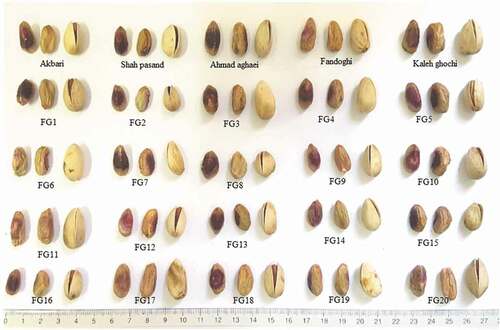
Among the measured quantitative characters, the percentage of blank nuts showed the highest coefficient of variation (CV = 51.19%), while the lowest CVs were found in kernel thickness (6.12%) and Kernel length (6.43%) (). The morphological traits with high coefficient of variation percentage can be used as reliable markers to study the genetic diversity among genotypes (Rezaei et al., Citation2019). The shape of terminal leaflet was predominantly broad lanceolate (47%), while the size of terminal leaflet was larger than basal leaflet in most of the selected genotypes (73%) (). Growth habit was spreading to upright in most of the genotypes (52%). Branching habit was intermediate in the majority of genotypes (72%). Shape of nuts was mainly ovoid (44%). Ghrab et al. (Citation2012) found that the majority of Tunisian pistachio landraces had an ovoid nut shape. Likewise, Rezaei et al. (Citation2019) observed an ovoid nut shape in most of the pistachio genotypes. The studied genotypes were grouped into four classes based on shell apex including flattened (12%), rounded (48%), symmetrically pointed (12%) and asymmetrically pointed (28%).
Table 2. Frequency distribution for the measured qualitative morphological characters in the studied pistachio genotypes
The percentage of blank nuts (productions), as a negative trait, ranged from 1.00% in FG18 to 23.00% in FG6 (, ). Ghrab et al. (Citation2012) found the range 2.00% to 62.00% blank nuts in Tunisian pistachio landraces, while Rezaei et al. (Citation2019) reported the range 2.63% to 98.46% in Iranian pistachio genotypes. In commercial cultivars, ‘Shah-pasand’ and ‘Fandoghi’ were found with low blank nut percentage in Damghan Climate (). ‘Shah pasand’ is a major local cultivar of Damghan in Iran. The blank nut percentage of 11 genotypes was less than 10.00 percentage. The average value of blank nuts percentage for studied genotypes was less than the pistachio genotypes which were studied by Rezaei et al. (Citation2019) and Ghrab et al. (Citation2012). The poor nutrition, lack of pollination and water deficiency during anthesis and kernel development affect embryo abortion (Abidi, Citation2016). The percentage of split nut (SN%) is one of important traits in pistachio production which influences pistachio marketing and economical value. The split nuts percentage ranged from 58% to 93% (, ). The FG14 genotype had the lowest split nuts percentage (58%) while FG13 genotype had the highest split nuts percentage (93%) (). The split nut percentage in 10 of 20 selected genotypes was more than 80%. More than 90% of nut in ‘Shah pasand’ and ‘Fandoghi’ was split (). The split nuts percentage in ‘Ahmad aghaei’, ‘Akbari’ and ‘Kaleh ghochi’ were respectively 81%, 75% and 82%. Boualem et al. (Citation2015) found the range of 9.62–85.75%, and Rezaei et al. (Citation2019) reported the range of 0.00% and 97.37% for split nut percentage. Increasing kernel weight and split nuts percentage and decreasing blank nuts percentage are important aspects of pistachio breeding programs (Chao et al., Citation1997; Rezaei et al., Citation2019). Thus, according to these aspects, the FG2, FG8, FG12 and FG13 were superior and can be used as new top pistachio cultivar or they can be used as parents in pistachio breeding programs.
Flowering Period
The pistachio is a dioecious tree that female flowers are receptive for only about four days. Consequently, the breeding programs that identify male genotypes with a high flowering period can increase the production rate and also decreasing blank nuts percentage (Chao et al., Citation2003). The bloom period of selected male genotypes was from April 10th to April 23rd (), and also the flowering period ranged from 4 to 12 days (). The MG2, MG3, MG4, MG10, MG11, and MG20 were early flowering, while MG21, MG15, MG19, and MG20 were late flowering genotypes. The MG20 genotype was shown a long flowering period (12 days) which covered all commercial pistachio cultivars except ‘Akbari’ (). In addition, ‘Kaleh ghochi’ was a late-flowering cultivar that had the lowest flowering period. Flowering time is different from a year to another, with slight differences. Various factors affect the flowering time that chilling requirement is the main factor determining the time of flowering in pistachio (Elloumi et al., Citation2013). Tree growing habit in 11 female genotypes was spreading and other’s female genotypes had a semi-erect and erect growth habit. MG3, MG8, MG11, and MG18 had erected, and the MG20 genotype had a semi-erect growing habit. The taller male pistachio trees can distribute pollens better. In addition, pollen viability and availability may affect blank nuts production and yield (Rezaei et al., Citation2019).
PCA Analysis
The principal component analysis (PCA) revealed that the first five principal components explained 65.5% of the total variance (). The first principal component covered 30.67% of total variability, that characters including the nut dry weight, kernel dry weight, shell dry weight, nut fresh weight, fruit fresh weight, nut length, kernel length, leaf length, leaflet length, leaf width, and leaflet width had the highest positive-coefficient values in first principal component, while number of kernels and number of nuts in 100 grams had the highest negative values (). Similarly, Rezaei et al. (Citation2019) reported that the first principal component was positively correlated with fruit weight, nut fresh weight, nut dry weight, length and width of nut, kernel length and kernel weight. In addition, Karimi et al. (Citation2009) found that the characters related to nut, leaf, and leaflet in pistachio genotypes had high coefficient values in the first principal component. The second component was significantly correlated with nut width, kernel width, and inflorescence rachis width. The kernel thickness correlated with the third component that accounted for 9.06% of the total variance. The fourth component was negatively correlated with the percentage of split nut and blank nuts production.
Table 3. Eigenvalues and eigenvectors of five principle components for pistachio genotypes
Scatter and Cluster Analyses
The loading scatters plot was drawn for PC1 and PC2 (), which indicated the importance of nut traits for explaining the variance among the genotypes. By starting from negative values to positive values of PC1, the female genotypes showed gradual increases in the nut dry weight, kernel dry weight, shell dry weight, nut fresh weight, fruit fresh weight, nut length, kernel length, leaf length, leaflet length, leaf width, and leaflet width, while these genotypes showed gradual decreases in number of fruits and nuts in 100 gram. Besides, starting from negative values to positive values of PC2, the female genotypes showed gradual increases in nut width, kernel width, and inflorescence rachis width.
Dendrogram of male genotypes based on morphological traits (13 variables) clustered genotypes into two main groups (). The first main group was divided into two sub-group that sub-group I-A contained six genotypes, while sub-group I-B included eight genotypes. The second main group contained 11 male-pistachio genotypes. In sub-group I-A, MG9, MG17, MG10, and MG15 genotypes were close relationships with ‘Akbari’ and ‘Fandogi’ cultivars. MG13 and MG16 positioned near ‘Kaleh ghochi’ and MG3 and MG5 placed close to ‘Shah Pasand’ and ‘Ahmad aghaei’. According to morphological and pomological fruit traits (41 variables), cluster analysis separated 25 female-pistachio genotypes into two main groups (). The first main group was included two sub-groups. Five female genotypes were placed in sub-group I-A, while eight genotypes were located in sub-group I-B. Also, the second main group comprised two sub-groups, that the sub-group II-A consisted of nine female genotypes, while three genotypes were placed in sub-group II-B. The close relation was presented between FG13, FG2 and ‘Fandoghi’; FG3 and ‘Kaleh ghochi’; FG11, FG4 and ‘Ahmad aghaei’ and ‘Akbari’; FG20, FG18 and ‘Shah pasand’.
Sensitivity Analysis with Neural Network
After training the data with the neural network, based on the highest correlation coefficient (r) and the lowest mean square error (mse), the number of hidden layer 2 was obtained. The composition of the function type w for the two hidden layers and the output data layer tansig, logsig and tansigas were also determined. The number of neurons in the hidden layers was 8 and 12, respectively. The correlation coefficient and mean square error for the total data were determined to be 0.99 and 16.378, respectively. In the sensitivity analysis, leaf length, inflorescence rachis length and inflorescence rachis width were determined based on the highest sensitivity coefficient. Based on the above table, the mean square error and correlation coefficient for leaf length were 0.87 and 140.781 and for inflorescence rachis length and width were 0.89, 105.29 and 0.89, 105.92 respectively (). According to neural network analysis, the morphological traits including leaf length, inflorescence rachis length and inflorescence rachis width have a significant impact on pistachio yield components. The previous pistachio studies Boualem et al., Citation2015; Kafkas and Perl-Treves, Citation2001; Karimi et al., Citation2009) also reported a positive correlation between nut weight and leaf size. Leaf size relates to the physiology process such as photosynthesis rate which increases photosynthesis capacity and eventually plants yield. It seems that the leaflet size can more effect on the weight of pistachio fruit, and this trait can be used as a morphological marker for screening the superior pistachio genotypes.
Table 4. Sensitivity analysis of 13 independent variables to most important traits of nut and kernel by the multilayer perceptron neural network (MLP)
Conclusion
Creating a large segregating population of open pollination is a simple breeding method to create superior varieties of fruit trees such as pistachios. The results show that the pistachio genotypes from open pollination seedling have a high phenological and pomological diversity. Selected male genotypes have a remarkable verity in the inflorescent opening, anthesis time and flowering periods which have great potential for introducing as male cultivar after passing complementary experiments on pollen compatibility and climate adaptability. MG20 was very interesting for its long flowering period. The survey of pomological traits related to nut and kernel in selected female genotypes especially FG17 and FG18 shows that are better performance than common commercial pistachio cultivars in Damghan climate, Iran. For assessing their adaptability and yield parameters, complementary field repeated experiments on different climate along with commercial cultivars are necessary. Scatter plot and cluster analyses showed the relationship between examined genotypes and cultivars which can be useful in breeding programs. The multilayer perceptron neural network (MLP) showed leaf length has high relation with nut and kernel properties which can be used to selecting superior genotypes in nursery at beginning of growth stages before transferring seedling to the field and reducing of the breeding program cost.
Author Contributions
All authors contributed to the study’s conception and design. Material preparation, data collection and analysis were performed by MR, SN and PH. The first draft of the manuscript was written by MR and PH. All authors approved the final manuscript.
Disclosure Statement
The authors confirm no conflict of interest.
References
- Abidi, W. 2016. Pomological and physical attributes of pistachio (Pistacia vera L.) varieties grown in west-central Tunisia. J. New Sci. 28:1582–1588.
- Aliakbarkhani, S.T., M. Akbari, A. Hassankhah, A. Talaie and M. Moghadam. 2015. Phenotypic and genotypic variation in Iranian Pistachios. J. Genet. Eng. Biotechnol. 13: 235–241.
- Baghizadeh, A., S. Noroozi, and M.J. Javaran. 2010. Study on genetic diversity of some Iranian Pistachio (Pistacia vera L.) cultivars using random amplified polymorphic DNA (RAPD), inter sequence repeat (ISSR) and simple sequence repeat (SSR) markers: A comparative study. African J. Biotechnol. 9:7632–7640.
- Benmahioul, B., N. Dorion, M. Kaid-Harche, and F. Daguin. 2012. Micropropagation and ex vitro rooting of pistachio (Pistacia vera L.). Plant Cell Tissue Organ Cult. 108:353–358.
- Boualem, S.A., K. Benabdeli, and A. Elouissi. 2015. Biochemical and biometrics characterization of five varieties of Pistacia vera L. grown in Moussa experimental station (northwest of Algeria). J. Chem. Pharm. Res. 7:1120–1130.
- Chao, C.T., D.E. Parfitt, L. Ferguson, C. Kallsen, and J. Maranto. 1997. Breeding and genetics of pistachio: The California program. In: II International Symposium on Pistachios and Almonds. California, USA 470. pp 152–161.
- Chao, C.T., D.E. Parfitt, L. Ferguson, C. Kallsen, and J. Maranto. 2003. Genetic analyses of phenological traits of pistachio (Pistacia vera L.). Euphytica. 129: 345–349.
- Elloumi, O., M. Ghrab, H. Kessentini, and M. Ben Mimoun. 2013. Chilling accumulation effects on performance of pistachio trees cv. Mateur in dry and warm area climate. Sci. Hortic. 159:80–87. doi: https://doi.org/10.1016/j.scienta.2013.05.004.
- Ghrab, M., F. Zribi, M.M. Ben, and A. Rhouma. 2012. Morphological investigation of genetic diversity of pistachio (Pistacia vera) germplasm in arid land of Tunisia. Plant Ecol. Evol. 145:363–372.
- Hammer, Ø., D.A.T. Harper, and P.D. Ryan. 2001. PAST: Paleontological Statistics Software Package for Education and Data Analysis Palaeontol. Electronica 4:1–9.
- Heidari, P., M. Rezaei, M. Sahebi, and A. Khadivi. 2019. Phenotypic variability of Pyrus boissieriana Buhse: Implications for conservation and breeding. Sci. Hortic. 247:1–8. doi: https://doi.org/10.1016/j.scienta.2018.11.075.
- Javanshah, A. 2010. Global warming has been affecting some morphological characters of pistachio trees (Pistacia vera L.). African J. Agric. Res. 5:3394–3401.
- Kafkas, S., H. Ozkan, B.E. Ak, I. Acar, S. H. Atli, and S. Koyuncu. 2006. Detecting DNA polymorphism and genetic diversity in a wide pistachio germplasm: Comparison of AFLP, ISSR, and RAPD markers. J. Am. Soc. Hortic. Sci. 131: 522–529.
- Kafkas, S., and R. Perl-Treves. 2001. Morphological and molecular phylogeny of Pistacia species in Turkey. Theor. Appl. Genet. 102:908–915.
- Kallsen, C., D. Parfitt, J. Maranto, and B. Holtz. 2009. New pistachio varieties show promise for California cultivation. Calif. Agric. 63:18–23.
- Karimi, H.R. 2012. Evaluation of the behavior of native Iranian pistachio species as rootstocks. J. Nuts. 4:41–46. doi: https://doi.org/10.22034/JON.2013.515713.
- Karimi, H.R., Z. Zamani, A. Ebadi, and M.R. Fatahi. 2009. Morphological diversity of Pistacia species in Iran. Genet. Resour. Crop. Evol. 56:561–571.
- Kazankaya, A., S. Tüfenkçi, M.F. Balta, and S. Karadag. 2008. Nutrient contents and nut properties of pistachio (Pistacia vera L.) varieties. Asian J. Chem. 20:2344–2348.
- Khadivi, A. 2018. Assessment of genetic variability in Pistachio (Pistacia vera L.) with nuclear SSR molecular markers. Erwerbs-Obstbau. 60(4): 289–294.
- Parfitt, D., C. Kallsen, and J. Maranto, 1995. Pistachio cultivars. Cent Fruit Nut Crop Res Information, Pomol Dept, Univ Calif, Davis CA 43–46.
- Pazouki, L., M. Mardi, P.S. Shanjani, M. Hagidimitriou, S. M. Pirseyedi, M. R. Naghavi, D. Avanzato, E. Vendramin, S. Kafkas, B. Ghareyazie, and M. R. Ghaffari. 2010. Genetic diversity and relationships among Pistacia species and cultivars. Conserv. Genet. 11: 311–318.
- Rezaei, M., H. Hokmabadi, A. Khadivi, A. Safari-Khuzani, and P. Heidari. 2019. The selection of superior pistachio (Pistacia vera L.) genotypes among seedling trees originated from open-pollination. Sci. Hortic. 251:88–100. doi:https://doi.org/10.1016/j.scienta.2019.02.083.
- Yarılgaç, T., and M. Yalcin. 2007. Pomological characteristics of pistachio (Pistacia vera L.) varieties grown in Gaziantep province. In: I Balkan Symposium on Fruit Growing Plovdiv, Bulgaria 825: 207–212.

